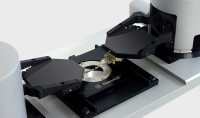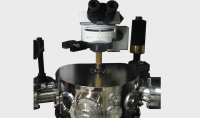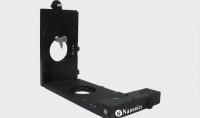
Reflection NSOM offers the ability to get high resolution imaging from opaque samples. To do effective reflection NSOM, a clear separation between the excitation path and the collection path is needed. Nanonics cantilevered NSOM probes easily provide for such a separation (picture) and allow for the easy reflection mode imaging. Straight NSOM probes or apertured Si probes use the same path for illumination and collection making such measurements nearly impossible. Reflection mode NSOM is ideal for mapping the optical properties of grain boundaries on Graphene and other 2D materials. Also Plasmonics and Photonic devices are often characterized in reflection mode NSOM.
AFM and NSOM images are simultaneity acquired with the same probe to obtain fully correlated topographic and NSOM data without any need to change the probe.
Key Features
-
Allows for study of Opaque samples
-
Gives Less light
-
More dependant on the probe tip
-
Ability to scan the NSOM probe in apertured NSOM
-
Local illumination with no background light
-
Cantilevered NSOM Probes
-
Clear optical view from above allowing for easy positioning
-
Clear separation of optical excitation and collection path
-
Real time optical and topography image at the same time
Exemplary Paper
Nano-optical Imaging of Exciton Polaritons Inside WSe2 Waveguides
Z. Fei, M. Scott, D. J. Gosztola, J. J. Foley, J. Yan, D. G. Mandrus, H. Wen, P., Zhou, D. W. Zhang, Y. Sun, J. R. Guest, S. K. Gray, W. Bao, G. P. Wiederrecht1, X., & Xu. (2014). Nano-optical imaging of exciton polaritons inside WSe2 waveguides, 11(7), 152–159.
Fei, et al studied exciton-polaritons in thin 260 nm flakes of WSe2. Using a Nanonics MultiView 4000 NSOM system in reflection NSOM mode (above, left) they could directly excite and probe exciton polariton modes by imaging their interference fringes in a method termed "scanning polariton interferometry" at different wavelengths (above middle, right). The near-field illumination allowed for the first time direct excitation and real imaging of the exciton polariton without the need for complicated cavity fabrication. Furthermore, by tuning the excitation laser energy it was possible to map the entire polarity dispersion.
 Imaging of the WSe2 thin flake. (left) Schematics of the near-field optical study of WSe2. (Middle and Right) Imaging data of a WSe2 flake (thickness = 260 nm) taken at various excitation wavelengths.
Imaging of the WSe2 thin flake. (left) Schematics of the near-field optical study of WSe2. (Middle and Right) Imaging data of a WSe2 flake (thickness = 260 nm) taken at various excitation wavelengths.
About the Authors
Dr. Zhe Fei is an assistant Professor and Iowa State University. His research interests are in Nanoscale light-matter interactions of novel materials such a two-dimensional layered materials. He has written many papers in the field of plasmons in leading publications as Nature, Nano Letters etc.
Exciting Applications
-
Waveguide characterization. With the new emerging waveguides, the importance to realize the topography and optical properties has become a necessity.

The above left image is an AFM image of a waveguide. The right image is the NSOM image. These two images were done simultaneously with the same probe. The graph shows a cross section of the NSOM signal showing a high resolution of ~100nm. Smaller and more efficient waveguides are being fabricated for the purpose of device application. With the NSOM Reflection mode one can tap into the photonics understanding of the waveguide in real correlation to the topography and features composing the sample.
By illuminating the near-field one can study the band gap of the different features on the surface of the waveguide hence receiving a correlating topographical and optical image using the same probe in real time.
-
Molecular configuration. This exciting field requires investigation at high resolution and sensitivity.
The optical response such as polarity can be a function of molecular spatial configuration. The NSOM reflection is an ideal tool to illuminate on a very specific location on the substrate, with no background light and detect in the far field the optical response. Our system can has the ability to excite and detect with polarizers and analyzers and in addition have optical filters.






